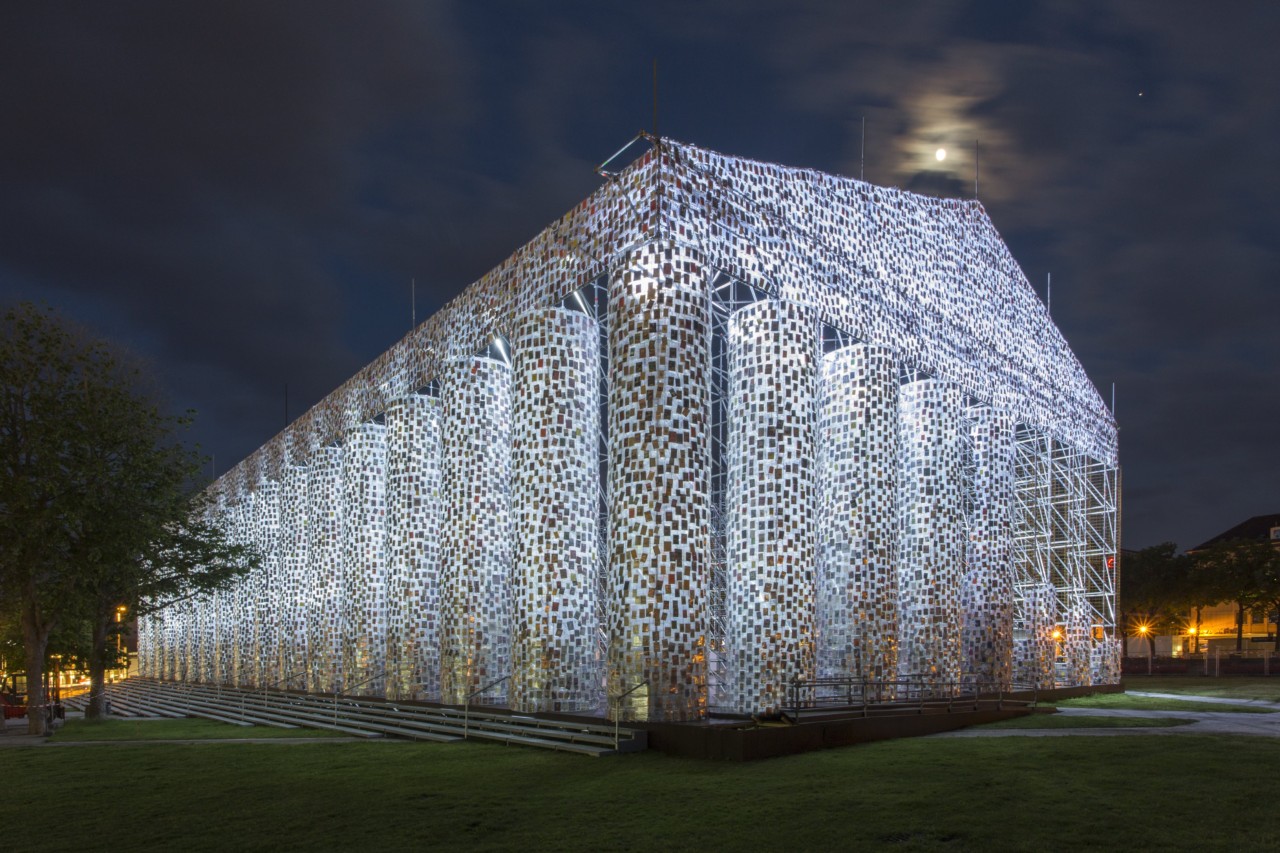


Marta Minujín, The Parthenon of Books, 2017, steel, books, and plastic sheeting, Friedrichsplatz, Kassel, documenta 14, photo: Roman März
When viewing the Kassel chapter of Documenta 14 the question frequently arises of how it relates to the Athens exhibition. The best analogy I can muster is a fugue: “a contrapuntal composition in which a short melody or phrase (the subject) is introduced by one part and successively taken up by others and developed by interweaving the parts.”
After Athens there is a feeling of déjà-vu, upon entering the Documenta Halle for example, when you are greeted by Beau Dick’s magnificent masks. It is also the first work you encounter at EMST in Athens. It’s often like bumping into new friends again and getting to know them better. The feeling of disorientation can be productive and oddly reminiscent of our current political situation. During the opening days of Documenta UK visitors were busy checking their phones for news of the general election and swapping notes when they bumped into each other, gathered in anxious huddles.
Whereas in Athens the Parthenon itself was visible from the roof of EMST, here it haunts the exhibition in reproduction, as a leitmotif. It appears in the background of German Romantic paintings in the Neue Galerie, the video work of Prinz Gholam in Documenta Halle, and is recreated in sculptural form out of banned books donated by the public in Marta Minujín’s The Parthenon of Banned Books (1983/2017). This is Documenta’s most photographed work and it glows beautifully in the long evening sunlight in Friedrichsplatz. Minujin first created this work in Argentina after the fall of the military junta in 1983, from books confiscated by the military.
The most successful venue in Kassel is the Neue Neue Galerie, an abandoned post office, which spoke of obsolete communication technology. Upstairs Irena Haiduk offers visitors the chance to purchase a pair of stylish Yugoexport shoes in Nine Hour Delay (2012-58). The Borosana shoes are a revived ergonomic design for factory workers from former Yugoslavia, designed to be comfortable when standing on a production line for nine hours. The price depends on your level of disposable income and you must sign a contract saying you will only wear them when working. A friend confirmed they were comfortable enough to withstand the walk around Documenta’s 32 venues.
Artur Żmijewski’s mesmerising six-channel installation Realism (2017) surrounds us with black and white close ups of athletic male lower limb amputees performing exercises. They appear to be victims of landmines. Is it a comment on the horrors of war or human resilience?
There are several public sculptures that will be seen by the citizens of Kassel even if they never enter one of the venues. In Konigsplatz stands Das Fremdlinge und Flüchtlinge Monument by Olu Oguibe, an obelisk with the words I was a stranger and you took me in [Matthew 25:35] inscribed on it in four languages, including Arabic. Oguibe survived the Biafran War as a child, which claimed 2 million lives, and made it the subject matter of his installation in Athens Biafra Time Capsule (2017). The monument is situated in a square where protests over the living conditions of refugees took place in 2015 and is a reaction to the anti-immigrant bigotry. Another is Kurdish artist Hiwa K’s When we were exhaling images (2017) – concrete pipes made into almost cosy outdoor living units. This work suggests a community, in contrast to his lonely concrete single bed exhibited in Athens.
Documenta 14 sets out to address the dark shadow of European colonialism and the Second World War. In Regina José Galindo’s powerful work The shadow (2017) at the Palais Bellevue, the artist runs away from a contemporary Leopard tank, produced in Germany. It follows her steadily, the gun sights on the back of her head. She runs through the local landscape – lush greenery and wind turbines – cinematic references abound, particularly the scene in North by Northwest in which Cary Grant runs towards the camera, away from a bi-plane that is strafing him. For me Galindo’s work reminds us that war is not a game or a movie. The petite figure of the artist panting raggedly as she runs from the relentless metal object reminds you searingly of the fragility of human flesh. Tanks have often been used on civilians to quell protest, most infamously in Tiannamen Square, and her work responds to the paradoxical history of Kassel. During the Second World War Kassel contained tank manufacturing plants that used forced labour from a nearby concentration camp. The centre of Kassel was flattened by Allied Bombs and on a single night, 22 October 1943, 10,000 people were killed. Today Germany is one of the top five arms manufacturers in the world.
In a drafty, abandoned underground station, the atmospheric KulturBahnhof, replete with graffiti and peeling advertisements, Michel Auder’s multi-channel text-film The Course of Empire (2017) seems to represent Documenta 14 in miniature. It is constructed of iPhone images of writings by James Baldwin, Donna J Haraway and Arthur Rimbaud installed in an overwhelming grid-like arrangement of screens.
The stated aim of the Documenta 14 artistic team is to provide marginalised artists with an unprecedented platform while challenging dominant political, economic and cultural systems. In this is succeeds heartily, offering a rare chance to see works by female artists, indigenous artists and older artists who have been neglected by the market. It gives us an exciting, inspiring and occasionally frustrating starting point for further research.
Ali MacGilp
Curator
documenta 14 in Athens continues until Sunday 16 July 2017, documenta 14 in Kassel runs from Saturday 10 June - Sunday 17 September 2017. www.documenta14.de